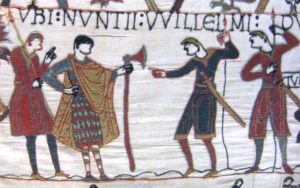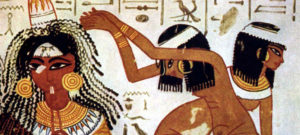The first written description of the personal appearance of the Vikings comes from a letter written by tenth-century English abbot Ælfric of Eynsham:
Ic secge eac ðe, broðor Eadweard…þæt ge doð unrihtlice þæt ge ða Engliscan þeawas forlætð þe eowre fæderas heoldon and hæðenra manna þeawas lufiað…and mid ðam geswuteliað þæt ge forseoð eower cynn and eowre yldran mid þam unþeawum þonne ge him on teonan tysliað eow on Denisc, ableredum hneccan and ablendum eagum.[1]
I say likewise to you, brother Edward…that you do unrightly when you forsake the English customs which our fathers held and hold dear the customs of heathen men…and by that make manifest that you scorn our kind and our forefathers with that evil practice by which you, to their shame, dress yourself in Danish fashion, with bald neck and blinded eyes.

The verb ablendan means “to blind,” and the long bangs hanging onto the foreheads and perhaps impeding the vision of certain warriors on the eleventh-century Bayeux tapestry might explain these “blinded eyes.” Other options for this “blinding” hinge on the description of the inhabitants of the city of Shalashwīq (Hedeby) given in the later tenth century by Ibrāhīm ibn Ya’qūb al-Isrā’īlī al-Turtūshī, a native of the Cordoban city of Tortosa,[2] who noted that “both men and women [there] use a kind of indelible cosmetic to enhance the beauty of their eyes.[3]
Speculation based on this and similarly loose translations has suggested white lead or even eye drops containing the alkaloid atropine, a compound present in deadly nightshade and henbane, as the “indelible cosmetic.” Both Dionysian furies and the ladies of the medieval Spanish court knew the pupil-dilating effect of the first substance, its association with beauty suggested in the name belladonna. Called hennebane, hennedwole, or hennebelle in Middle English herbals, black henbane was used in medieval England and Viking Scandinavia, and its seeds—their psychoactive effects linked to berserker behavior—have been found in some quantity in Viking graves.
Despite the attractions of these toxic European plants, a closer look at the original text gives a reading that points in another direction. Ibrāhīm writes:
وبها كحل مصنوع اذا اكتحلوا به لا يزول ابدا ويزيد الحسن في الرجال والنساء[4]
“…on them is fabricated kohl, if they color their eyes with it, which never vanishes and beauty increases among men and women.”

Ibrāhīm actually describes the Danes at Hedeby as lining their eyes with kohl (كُحْل kuḥl), a cosmetic widely used in the Middle East, the Mediterranean, and north Africa and particularly recommended by the prophet Muhammad. Though we will likely never know how exactly the Danes “blinded” their eyes, Ibrāhīm’s description points to fascinating global connections in the tenth century, from Scandinavian raiders in England to Cordoban Jews visiting northern Germany, suggesting a more inclusive picture of history than traditional narratives tend to imagine and reminding us that the middle ages really were the crossroads of everything.
Rebecca West, PhD Candidate
University of Notre Dame
[1] Mary Clayton, “An Edition of Ælfric’s Letter to Brother Edward,” in Early Medieval English Texts and Interpretations: Studies Presented to Donald G. Scragg, ed. Elaine M. Treharne, Susan Rosser, and D. G. Scragg (Tempe, AZ: Arizona Center for Medieval and Renaissance Studies, 2002), 280, 282.
[2] Schleswig, (Hedeby), now in northern Germany but even into the modern period intermittently under Danish control. The section discussed here is transmitted in the 1068 Kitāb al-masālik wa’l-mamālik (Book of Roads and Kingdoms) of Hispano-Arabic geographer, botanist, and historian Abū ‘Ubayd al-Bakrī.
[3] Aḥmad Ibn Faḍlān, Ibn Fadlan and the Land of Darkness: Arab Travellers in the Far North, trans. Paul Lunde and Caroline Stone (London: Penguin, 2012), 163.
[4] (wa-bihā kuḥl maṣnū‘ idhā ktaḥalū bihī lā yazūlu abadan wa-yazīdu l-ḥasan fī l-rijāl wa-l-nisā’) Zakarīyā ibn Muḥammad al-Qazwīnī and Ferdinand Wüstenfeld, Zakarija Ben Muhammed Ben Mahmûd El-Cazwini’s Kosmographie, vol. 2 (Göttingen: Verlag der Dieterichschen Buchhandlung, 1849), 404. Thanks to Alexander Beihammer for his help with the Arabic text.
